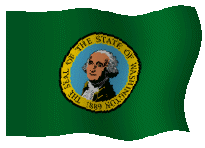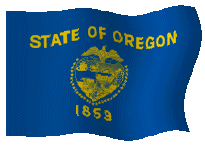

THE HOME WINE COURSE ©
Introduction:
The relatively recent wine-producing regions of Washington and Oregon are perhaps the most exciting addition to the world's wine destinations. Spectacular early successes with white wines in Washington state and with the finicky Pinot Noir in Oregon put the Great Northwest on the wine map in the eyes of many connoisseurs and enthusiasts. The Columbia River connects these two states and at this juncture similar wines are being produced on opposing sides of the river border (Walla Walla). Both states have the Cascade Mountain Range traversing their mid-sections from north to south but the great difference between these two neighbors lies in the location of vineyards relative to this massive mountainous barrier. Washington vineyards are principally located east of the Cascades whereas Oregon vineyards are situated to the west. This fact alone determines the other great difference between Washington and Oregon wines - climate - and the wine varietals which do best under the specific weather and soil conditions found on either side of the Cascades. The semi-arid conditions of eastern Washington favors warm-loving varietals such as Merlot, Cabernet Sauvignon, and Sauvignon Blanc while the maritime-influenced western Oregon climate is ideal for cool-loving varietals such as Pinot Noir and Pinot Gris. Consequently each of these states' wine industries is known best for the the wine types we've just mentioned.
Levels of Quality
Both Washington and Oregon have federally-approved AVA wine growing districts (American Viticultural Areas) that are now well-established legally but not quite so well known to the average wine consumer. The two districts with the most name recognition are the Columbia River Valley of Washington and the Willamette River Valley of Oregon. (There are several other appellations which we'll mention later.) Quality designators in both states follow the pattern originated in California with Reserve notations used for more special wines and single vineyard status indicated where appropriate. Fancifully-named proprietary labels (which sometimes can be very confusing) are rarely used on Pacific Northwest wines. It also should be noted that wine producers of the Northwest are generally more strict about their use of Reserve and Private Reserve designations than their market-minded Californian counterparts so when these terms are used on a Washington or Oregon wine label they usually identify the winery's best efforts.
Grape Types
As was the case in California, vintners of the Pacific Northwest tried their hand with a plethora of grape varietals in the early days of open experimentation. Creative winemakers continue to try new varietals even today such as the Muller-Thurgau wines of Chateau Benoit in Oregon. Yet, due to the generally cooler climate found in Washington and especially in Oregon, varietal choices are somewhat more limited than in California. Washington premium Cabernet Sauvignon and Merlot wines have become the darlings of wine enthusiasts due to their Bordeaux-like complexity and more generally more affordable prices. Washington also does exceptionally well with the white Bordeaux varietals, Sauvignon Blanc and Semillon. Both states are capable of producing quality White Riesling and Gewurztraminer. These Germanic varietals seem to have much more purity of character than those produced in California. In Oregon Pinot Noir is the crown prince of all grapes types grown in the state. Many Oregonian Pinots have been compared quite favorably with much more expensive French red Burgundy. The most successful white wine produced in Oregon has to be the Pinot Gris. This varietal (the prized Pinot Grigio of northeastern Italy) is responsible for some of the finest dry white wines of the state. Stylistically it is usually heavier than French or Italian versions and can handle extended barrel age much like Chardonnay. As for Chardonnay there are excellent versions of this wine produced in nearly every district of the Pacific Northwest. Northwestern Chardonnays are typically quite elegant as opposed to being powerful (á la California) with juicy pear and citrus flavors and lighter oak shadings.
Regions of Production
We've already touched on this area of consideration in the introduction but it would be useful to expand on the subject further. In Washington the principle viticultural regions (AVAs) are the Columbia Valley, Yakima Valley, and Walla Walla Valley (just south of the state line) all situated east of the Cascades. The Yakima Valley by far has the most vineyards of the three AVAs. Most of the winegrape harvest is shipped west 150 miles to wineries situated around Seattle although there is an increasing number of winery facilities being constructed near the vineyard source. In Oregon, west of the Cascade Mountains but east of the Coast Ranges, there are also three primary growing districts. They are the Willamette Valley (from the Columbia River south to just north of Salem), the Umpqua Valley (centered around the town of Roseburg south of Eugene), and the Rogue Valley (just north of the California border near the towns of Medford and Ashland). The Willamette Valley holds almost two-thirds of all Oregonian winery operations with most of these situated in Yamhill County about 20 miles south of Portland. Other sub-appellations are gaining in importance however and they include Washington County, the Red Hills district (near the town of Dundee), and the Eola Hills district (northwest of Salem).
Summary
Don't expect the wines of the Pacific Northwest to taste like California wines. They are well-balanced but not overly fruity in style. The reds of both Washington and Oregon seem to call for hearty cuisine: grilled meats, game fowl, or stronger cheeses. The dry whites, so essentially honest and lively, are perfect as palate-cleansing aperitifs or when served with French-style sauces. And, of course, the spicy, floral Rieslings and Gewurztraminers are a match made in heaven for hot and spicy Asian, Indian, or Mexican cuisine!
Tasting Notes: